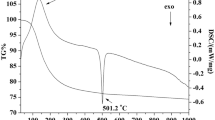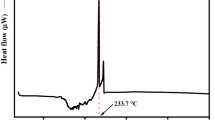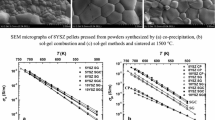Abstract
The properties of yttria stabilized zirconia(YSZ) related to the sintering process were discussed. YSZ nano-powders about 40–100 nm as raw material, the sub-micrometer grain sizes such as 0.4–3 μm in YSZ were gotten by sintering process at 1300 °C, which was performed at 1000 °C for 2 h, then raised the temperature at the rate of 50 °C/h to 1400 °C, then decreased directly to 1300 °C in 30 minutes, finally at 1300 °C for 5–20 hours. The ratio of bigger grain size becomes larger as the holding time increasing at 1300 °C. The grains less than 1 μm are about 50%, eg, 43.2%, 52.2% and 51.1% related to 1300 °C holding 5 hours, 8 hours and 10 hours, respectively. As YSZ grain size became small, the electrical conductivities did not decrease, even increased, about 0.20 s/cm at 1000 °C. The reduced sintering temperature and time were benefited to co-fire with the electrodes in electrode-supported SOFCs.
Similar content being viewed by others
References
N Q Minh, T Takahashi. Science and Technology of Ceramic Fuel Cells[M]. Elsevier, Amsterdam, 1995
R N Basu, Günter Blass. Simplified Processing of Anode-supported Thin Film Planar Solid Oxide Fuel Cells[J]. Journal of the European Ceramic Society, 2005, 25(4):463–471
Himeko Orui, Kimitaka Watanabe, Masayasu Arakara. Electrochemical Characteristics of Tubular Flat-plate-SOFCs Fabricated by Co-firing Cathode Substrate and Electrolyte[J]. Journal of Power Sources, 2002, 112(1):90–97
S C Singhal and Kevin Kendall. High Temperature Solid Oxide Fuel Cells: Fundamentals, Design and Applications[M], p.5–8, 89, Elsevier Advanced Technology, The Boulevard, Langford Lane, Kidlington Oxford OX5 1GB, UK(2004)
S D Souza, S J Visco, L C De Jonghe. Thin-film Solid Oxide Fuel Cell with High Performance at Low Temperature[J]. Solid State Ionic, 1997, 98(1–2):57–61
Keiji Yamahara, C P Jacobson, Steven J Visco, et al. Catalyst-infiltrated Supporting Cathode for Thin-film SOFCs[J]. Solid State Ionics, 2005, 176(5–6):451–456
J L Shi, M L Ruan & T S Yen. Crystallite Growth in Yttria-Doped Superfine Zirconia Powders and Their Compacts: A Comparison between Y-TZP and YSZ[J]. Ceramics International, 1996, 22(2):137–142
Minfang Han, Suping Peng, Zaihong Sun, Qunxing Duan. Manufacture Processing and Properties of Stabilized ZrO 2 Ultra Fine Powders for SOFC[C]. In: Proceeding of US-China Clean Energy Technology Forum, Vol I, Beijing, China, 2001:161–169
Minfang HAN, Cuibai YANG, Botao LI, Suping Peng. Properties of YSZ Electrolyte Thin Film by Tape Calendaring Process[J]. Battery. 2004, 34(3):207–208(in Chinese)
Huiyan Yin, Minfang Han. Grain Characteristics of Nanocrystalline ZrO2 Powders[J]. Key Engineering Materials, 2007, 336–338(3):2558–2561
Minfang Han, Lijun Huo, Botao Li, Suping PENG. Relation between Powder Size and Electrolyte Properties in the Nano YSZ System[J]. Journal of University of Science and Technology Beijing, 2005, 12(1):78–80
Minfang Han, Botao Li, Suping Peng. Manufacture Process of 8Y2O3 Stabilized ZrO2 from Nano Powders[J]. Journal of Wuhan University of Technology. Material Science, 2004, 19(3):10–13
Minfang Han, Suping Peng, Botao Li. Grain Characters and Sintering Properties of YSZ Nanocrystalline Powders[J]. Rare Metal Materials and Engineering, 2003, 32:491–495
X J Chen, K A Khor, S H Chan, et al. Influence of Microstructure on the Ionic Conductivity of Yttria-stabilized Zirconia Electrolyte[J]. Materials Science and Engineering A, 2002, 335(1–2):246–252
P Mondal, A Klein, W Jaegermann, H Hahn. Enhanced Specific Grain Boundary Conductivity in Nanocrystalline Y2O3-stabilized Zirconia[J]. Solid State Ionic, 1999, 118(3–4):331–339
Author information
Authors and Affiliations
Corresponding author
Additional information
Funded by the National Natural Science Foundation of China (NSFC) (No. 50730004) and the New Century Elitist Project (No. NCET-06-0203)
Rights and permissions
About this article
Cite this article
Han, M., Tang, X. & Shao, W. The properties of YSZ electrolyte sintering at 1300 °C. J. Wuhan Univ. Technol.-Mat. Sci. Edit. 23, 775–778 (2008). https://doi.org/10.1007/s11595-007-6775-6
Received:
Accepted:
Published:
Issue Date:
DOI: https://doi.org/10.1007/s11595-007-6775-6




